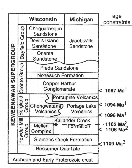


The oldest unequivocal rift rocks exposed in northern Wisconsin and upper Michigan are quartz-rich fluvial and lacustrine sandstones of the Bessemer Quartzite. These were deposited in a broad basin in response to initial thinning of the crust on the site of the future rift (Ojakangas and Morey, 1982).
A thick succession of rift-filling clastic sedimentary rocks, the Oronto Group, overlies the rift-filling volcanic rocks. These rocks represent the change from a period dominated by volcanism to one dominated by sedimentation.
When magmatic activity waned, subsidence of the rift basin continued as the thermal anomaly of the mantle plume decayed (Hutchinson and others, 1990; Cannon and Hinze, 1992). A total thickness of up to 8 km of rift-filling clastic sedimentary rocks exist beneath the center of Lake Superior, with a maximum exposed thickness in the western Upper Michigan of 6 km (Cannon and others, 1989; Cannon, 1992).
The Oronto Group is subdivided into three formations: 1) the Copper Harbor Conglomerate, dominated by coarse red alluvial fan conglomerates; 2) the Nonesuch Shale, a thin intervening lacustrine gray to black shale mineralized with copper sulfides over a wide area, but with economic concentrations only near White Pine, Michigan; and 3) the Freda Sandstone, composed of fluvial red sandstones.
Cannon and others (1989) and Hinze and others (1990) propose that late in the thermal subsidence phase of the rift, mature lacustrine and fluvial red sandstones of the Bayfield Group were deposited across the entire basin. In Wisconsin, the three formations of the group are the Orienta, Devils Island, and Chequamegon Sandstones (Thwaites, 1912; Morey and Ojakangas, 1982). In Michigan, the Jacobsville Sandstone is the approximate stratigraphic equivalent of the Bayfield Group.